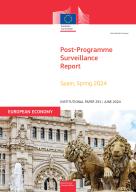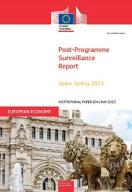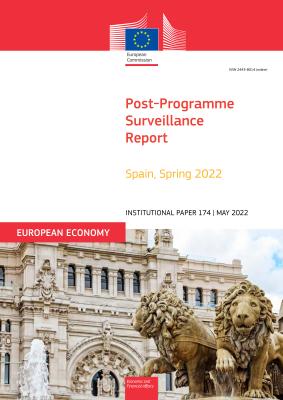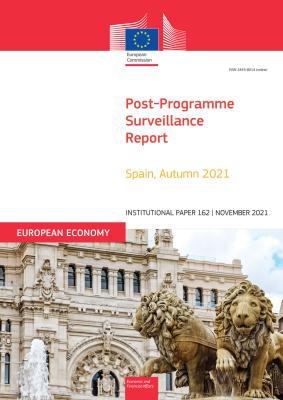Summary
Spain successfully exited the financial assistance programme for the recapitalisation of financial institutions in January 2014. The programme had been agreed by the Eurogroup in July 2012 for a period of 18 months and provided an external financing by euro area countries of up to €100 billion.
Post-programme surveillance
Spain used around €38.9 billion for bank recapitalisation, under restructuring and resolution plans approved by the European Commission under state aid rules, and around €2.5 billion for capitalising Sareb (the Spanish asset management company). Both the bank-specific conditionality and the horizontal conditionality included in the memorandum of understanding (MoU) were fulfilled as scheduled
After exiting the programme, the monitoring of the Spanish economy and its financial sector continues in the context of the post-programme surveillance (PPS), outlined in Regulation (EU) N°472/2013.
PPS starts after the expiry of the programme and monitors of the repayment capacity of a country having received financial assistance. Country missions take place twice a year, along with published reports.
Key elements of the programme for Spain
The July 2012 MoU included both bank-specific conditionality, in line with State aid rules, and horizontal conditionality. Even though the financial assistance was provided for a period of 18 months, the restructuring of the banks receiving public support under the State aid rules is expected to take up to five years.
The bank-specific conditionality had 3 main components
- a comprehensive diagnostic as regards the capital needs of individual banks, based on a comprehensive asset quality review and valuation process, as well as bank-by-bank stress tests.
- the segregation of impaired assets from the balance sheet of banks receiving public support and their transfer to an external asset management company (Sareb)
- the recapitalisation and restructuring of viable banks and an orderly resolution of non-viable banks, with private sector burden-sharing as a prerequisite
Horizontal conditionality applied to the entire banking sector and included measures aimed at
- strengthening regulatory, supervisory and bank resolution frameworks
- enhancing the governance structure of savings and commercial banks
- improving consumer protection legislation as regards the sale by banks of subordinated debt instruments
The Commission ,ECB and the European Banking Authority (EBA), verified at quarterly intervals that the policy conditions attached to the financial assistance were fulfilled, through missions and regular reporting by the Spanish authorities. In addition, the IMF supported the implementation and monitoring of the programme with advice and regular reporting.
Reports

- Report
- Directorate-General for Economic and Financial Affairs
This report by the European Commission presents the findings of the 21th post-programme surveillance mission to Spain and identifies remaining challenges.

- Report
- Directorate-General for Economic and Financial Affairs
This report by the European Commission presents the findings of the 20th post-programme surveillance mission to Spain and identifies remaining challenges.

- Report
- Directorate-General for Economic and Financial Affairs
This report by the European Commission presents the findings of the 19th post-programme surveillance mission to Spain and identifies remaining challenges.

- Report
- Directorate-General for Economic and Financial Affairs
This report by the European Commission presents the findings of the 17th post-programme surveillance mission to Spain and identifies remaining challenges.

- Report
- Directorate-General for Economic and Financial Affairs
This report by the European Commission presents the findings of the 16th post-programme surveillance mission to Spain and identifies remaining challenges.
Archived reports
Post-Programme Surveillance Report – Spain, Spring 2015 (Occasional paper 211, May 2015)
Post Programme Surveillance - Autumn 2014 Report (Occasional papers 206, December 2014)
Post Programme Surveillance – Spring 2014 Report (Occasional papers 193, May 2014)
Financial Assistance Programme for the Recapitalisation of Financial Institutions in Spain. 5th review – Winter 2014 (Occasional papers 170, January 2014)
The Spanish financial-sector programme over 2012-13 - Key features and achievements (Presentation, January 2014)
Financial Assistance Programme for the Recapitalisation of Financial Institutions in Spain. 4th review – Autumn 2013 (Occasional papers 163, November 2013)
Financial Assistance Programme for the Recapitalisation of Financial Institutions in Spain. 3rd review of the programme – Summer 2013 (Occasional papers 155, July 2013)
Financial Assistance Programme for the Recapitalisation of Financial Institutions in Spain. 2nd review of the programme – Spring 2013 (Occasional papers 130, March 2013)
Financial Assistance Programme for the Recapitalisation of Financial Institutions in Spain. Update on Spain's compliance with the Programme - Winter 2013 (Occasional papers 126, January 2013)
Financial Assistance Programme for the Recapitalisation of Financial Institutions in Spain. First review - Autumn 2012 (Occasional papers 121, November 2012)
The Financial Sector Adjustment Programme for Spain (Occasional papers 118, October 2012)
Related publications
International Capital Flows and the Boom-Bust Cycle in Spain (Economic papers 519, June 2014)
Assessing the impact of a revenue-neutral tax shift away from labour income in Spain (Country Focus, April 2014)
IDR Macroeconomic imbalances - Spain 2014 (Occasional papers 176, March 2014)
Spanish housing market: adjustment and implications (Country Focus, December 2013)
Macroeconomic Imbalances (Occasional papers 134, March 2013)
Macroeconomic Imbalances (Occasional papers 103, July 2012)
